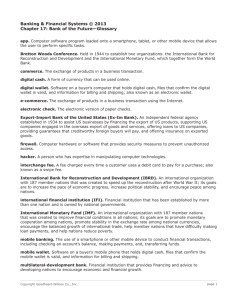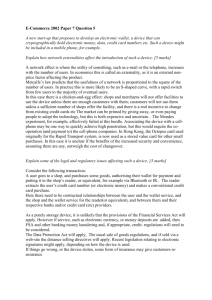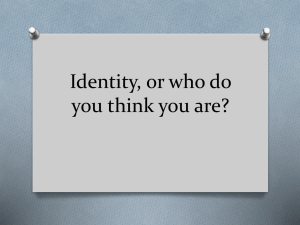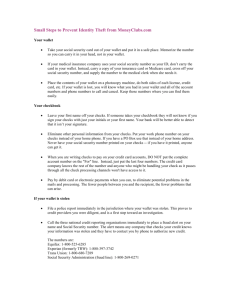Opening the digital wallet: a wealth of opportunity (and risk)
advertisement
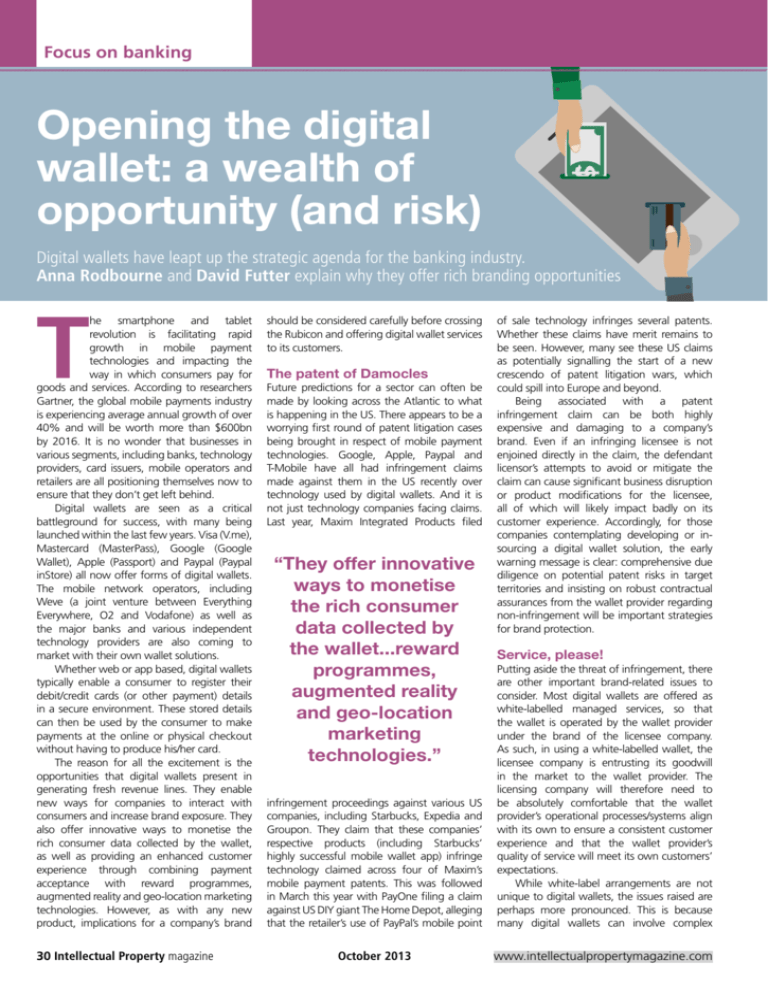
Focus on banking Opening the digital wallet: a wealth of opportunity (and risk) Digital wallets have leapt up the strategic agenda for the banking industry. Anna Rodbourne and David Futter explain why they offer rich branding opportunities T he smartphone and tablet revolution is facilitating rapid growth in mobile payment technologies and impacting the way in which consumers pay for goods and services. According to researchers Gartner, the global mobile payments industry is experiencing average annual growth of over 40% and will be worth more than $600bn by 2016. It is no wonder that businesses in various segments, including banks, technology providers, card issuers, mobile operators and retailers are all positioning themselves now to ensure that they don’t get left behind. Digital wallets are seen as a critical battleground for success, with many being launched within the last few years. Visa (V.me), Mastercard (MasterPass), Google (Google Wallet), Apple (Passport) and Paypal (Paypal inStore) all now offer forms of digital wallets. The mobile network operators, including Weve (a joint venture between Everything Everywhere, O2 and Vodafone) as well as the major banks and various independent technology providers are also coming to market with their own wallet solutions. Whether web or app based, digital wallets typically enable a consumer to register their debit/credit cards (or other payment) details in a secure environment. These stored details can then be used by the consumer to make payments at the online or physical checkout without having to produce his/her card. The reason for all the excitement is the opportunities that digital wallets present in generating fresh revenue lines. They enable new ways for companies to interact with consumers and increase brand exposure. They also offer innovative ways to monetise the rich consumer data collected by the wallet, as well as providing an enhanced customer experience through combining payment acceptance with reward programmes, augmented reality and geo-location marketing technologies. However, as with any new product, implications for a company’s brand 30 Intellectual Property magazine should be considered carefully before crossing the Rubicon and offering digital wallet services to its customers. The patent of Damocles Future predictions for a sector can often be made by looking across the Atlantic to what is happening in the US. There appears to be a worrying first round of patent litigation cases being brought in respect of mobile payment technologies. Google, Apple, Paypal and T-Mobile have all had infringement claims made against them in the US recently over technology used by digital wallets. And it is not just technology companies facing claims. Last year, Maxim Integrated Products filed “They offer innovative ways to monetise the rich consumer data collected by the wallet...reward programmes, augmented reality and geo-location marketing technologies.” of sale technology infringes several patents. Whether these claims have merit remains to be seen. However, many see these US claims as potentially signalling the start of a new crescendo of patent litigation wars, which could spill into Europe and beyond. Being associated with a patent infringement claim can be both highly expensive and damaging to a company’s brand. Even if an infringing licensee is not enjoined directly in the claim, the defendant licensor’s attempts to avoid or mitigate the claim can cause significant business disruption or product modifications for the licensee, all of which will likely impact badly on its customer experience. Accordingly, for those companies contemplating developing or insourcing a digital wallet solution, the early warning message is clear: comprehensive due diligence on potential patent risks in target territories and insisting on robust contractual assurances from the wallet provider regarding non-infringement will be important strategies for brand protection. Service, please! infringement proceedings against various US companies, including Starbucks, Expedia and Groupon. They claim that these companies’ respective products (including Starbucks’ highly successful mobile wallet app) infringe technology claimed across four of Maxim’s mobile payment patents. This was followed in March this year with PayOne filing a claim against US DIY giant The Home Depot, alleging that the retailer’s use of PayPal’s mobile point Putting aside the threat of infringement, there are other important brand-related issues to consider. Most digital wallets are offered as white-labelled managed services, so that the wallet is operated by the wallet provider under the brand of the licensee company. As such, in using a white-labelled wallet, the licensee company is entrusting its goodwill in the market to the wallet provider. The licensing company will therefore need to be absolutely comfortable that the wallet provider’s operational processes/systems align with its own to ensure a consistent customer experience and that the wallet provider’s quality of service will meet its own customers’ expectations. While white-label arrangements are not unique to digital wallets, the issues raised are perhaps more pronounced. This is because many digital wallets can involve complex October 2013 www.intellectualpropertymagazine.com Focus on banking ecosystems and subcontracting structures. This is especially the case for those digital wallets which include mobile contactless payment technology, such as near-field communication technology (NFC) or quick response (QR) codes, whereby the storage, transmission and processing of the payment card data and other associated sensitive authentication data is conducted on behalf of the wallet provider by trusted service managers (TSMs) or other third party processors. Accordingly, for most digital wallets, appropriate service levels and performance incentives ought to be key features of the wallet agreement. Such incentives should include meaningful service credits, the right to render the relationship non-exclusive (where relevant) and, ultimately, clear termination rights for sub-standard performance. In terms of service levels, the wallet provider should clearly commit to an assured level of wallet availability (uptimes of 99.5% or higher are not uncommon) as well as customer support/helpdesk service levels. In addition, other metrics which relate to those service elements potentially impacting on end user experience need to be considered. These can include: maximum wallet login and activity response latencies (eg, account balance retrieval time), payment processing speed (particularly important for certain sectors, such as fashion retail, where queue time is critical) and security testing and vulnerability thresholds. commercial remuneration associated with the transaction. Where the wallet is being provided on a white-labelled basis, most consumers will naturally presume that the licensee company, rather than the wallet provider, is processing their data. Accordingly, any data incidents, such as unauthorised access, data loss, unsolicited marketing or mis-handled complaints will first and foremost harm the licensee company’s market reputation. This risk can be difficult to mitigate in practice; nevertheless, ensuring that wallet’s data privacy policy delineates very clearly the data arrangements can help, as can retaining sufficient control over how the wallet provider processes the data in operating the wallet service. What (brand) is in your wallet? One of the key drivers for digital wallet providers is the opportunity to develop and leverage enhanced customer data. Much more personalised and, therefore, valuable marketing can be achieved by combining a purchaser’s identity and other personal information (which the consumer provides when registering the wallet) with their basket and transaction level data (which is captured by the wallet and/or retailer at the point of sale). Few companies are able to cross-match and exploit both data sets – supermarkets, through their loyalty cards, are a lonely exception. While it may be advantageous for a retailer to access and use customer data captured by its digital wallet provider to tailor its marketing campaigns, the retailer needs to understand what rights over its customer’s data the wallet provider is seeking to obtain in return. The data is unlikely to be protected by any database right, so it is important that the contractual position is clear as to who owns the data and what rights each party has in respect of it. Often, use of a retailer’s customer data (particularly at the basket/SKU level) will be as valuable to the wallet provider as the Branding strategy for digital wallets is crucial. For retailers, the digital wallet’s direct link to the customer is seen as central to reinforcing their brand awareness and visibility. Whereas for financial institutions, the digital wallet’s brand is arguably even more important: a successful digital wallet’s brand is set to become a valuable trademark in its own right for payment acceptance, competing alongside the existing payment brands at point of sale (much like Paypal has achieved for e-commerce). Until very recently, this “top of the wallet” battle has largely led banks, card issuers and the card schemes to offer restricted, own branded wallets, through which they design, control and manage the wallet’s functionality to limit them to their own services only. Card issuers, in particular, have been disinclined to enable their cards to be provisioned into competing branded wallets. However, the payment industry is beginning to realise that, in order to avoid market fragmentation and to drive mass uptake, a less restricted approach may be needed. For digital wallets truly to take off, the solution must provide for a convenient and effective customer experience, which is likely to involve a number of competing brands sitting alongside each other within a single wallet. Providers and users of these so-called “integrated” digital wallets will need to think carefully about how they structure the necessary trademark licensing arrangements; undoubtedly each brand owner will be looking for prominence, adequate quality control around the use of their mark and an apportionment of goodwill generated by the wallet. Balancing these requirements for each of the participants involved will be challenging. As demand for mobile payments continues to grow, a comprehensive and considered strategy for using digital wallets www.intellectualpropertymagazine.com October 2013 Owning the customer Checklist when con sidering a label digit white al wallet: • Engage early with your busin stakeholde ess rs to raise IP, data an branding is d sues. • Examin e carefully the vendor’ reputation s , financial and technic resources. al • Ask the vendo including w r to explain its IP stra tegy, hat patent due diligen has done in ce it your key te rritories. • Unders tand the ve n d or’s intenti your custo ons for mer data a nd relation • If locate ship. d outside th e UK, asse vendor’s ju ss the risdiction; particularly enforceme around nt of contr actual rem edies. will be important for many. Companies contemplating developing or procuring a digital wallet, either to license to others in the payments value chain or to offer to end consumers themselves, should consider carefully the IP and branding issues arising from this relatively nascent product offering. A company’s successful and efficient deployment of a digital wallet will depend upon it first developing a clear approach as to how best to address these issues so as to maximise the very significant commercial benefits this technology can deliver. Authors Anna Rodbourne is a partner and David Futter a managing associate at Addleshaw Goddard. Anna is a commercial lawyer and leading advisor on payments transactions, advising a range of payment network participants, particularly the banks, on digital, mobile and other payments related issues and projects. David is a commercial, technology and IP lawyer, specialising in advising banks, card issuers, acquirers and merchants on their digital payment products and transactions. He led negotiations for Visa Europe on the development of their V.me digital wallet. Intellectual Property magazine 31
